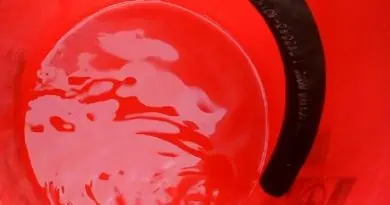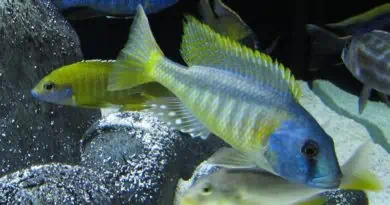Buying African Cichlids
The most exciting part of the hobby for me is buying African cichlids for my tank. I think it’s the same for most people based on how popular fish unboxing videos have been on YouTube.
There are 2 approaches to go about stocking your tank. Either you buy unsexed juvenile fish and grow them out yourself or you buy adult fish.
Buying juvenile African cichlids:
Buying adult African cichlids:
Sources for African cichlids:
Selecting a potential male from a group of juvenile cichlids:
Young African cichlids fed hormone food:
Adding new African cichlids to your tank:
Buying juvenile African cichlids:
- Buying juvenile cichlids is the most cost-effective way to stock your tank. You will pay only a fraction the price you would pay for adult fish.
- You get to enjoy the development process as the fish mature into large colourful adults.
- Younger fish are less aggressive than adults.
However, there are some downsides
- It is difficult to determine whether the fish is male or female. If you are planning for an all-male tank you will need to remove the fish later when it becomes obvious that it is a female.
- Additionally, you cannot tell the quality of the fish. Will it have the colour and shape you are hoping for?
- It’s going to take a while for the fish to grow and the color to develop.
Buying adult African cichlids:
- Adult cichlids are expensive. Especially if you are stocking a new display tank and need to buy 10 fish or more for your initial setup.
- You get to see the quality and colour of the fish you are buying and there is no guess work as to whether the fish is male or female. However, there is no guarantee that the fish will hold this colour when added to a display tank.
- Adult cichlids are much more aggressive than juveniles. Once the hierarchy is established in the tank it will be difficult to add new fish.
- Adult fish struggle more with the stress associated with adapting to a new environment.
Sources for African cichlids:
Your LFS may stock some of the more common cichlids and it’s a good place to start. Usually, they with have a mixed African cichlids tank for you to choose from. My journey into keeping Malawi cichlids began in an LFS after seeing a Eureka Red peacock cichlid being kept alone in a small display tank.
There are plenty of reputable African cichlid breeders with online platforms for purchasing Malawi cichlids. These are a great option for getting high quality fish of various sizes. Some even offer starter packs containing 5 or 10 different types of Malawi cichlids. You don’t get to pick the fish personally but can be assured of the quality.
Another option is to buy from other fish keepers. You may find someone selling cichlids or small-time breeders in your area. It’s good to be involved in Facebook groups or local clubs to get connected and for support with your questions.
Selecting a potential male from a group of juvenile cichlids:
There are a few things to look for when trying to pick out a young male from a group of juvenile Malawi cichlids.
To start off you need to know what the male and female of that species look like. I like to watch YouTube breeding group videos for that particular species to see the differences.
Below are some general tips but it will also depend on the traits of that species.
- The first thing I look for is faint blue or green colour beginning to show on the jaw line or gill plate. This is easier to notice when looking up from slightly below the level of the fish.
- Colour or blaze starting to develop on the dorsal fin. Is it more than the trim a female would normally have?
- Males usually have a pointed anal fin. Look for young fish with a more pointed than round anal fin.
- In most species egg spots are only present in male fish. Look for signs of that the fish is developing egg spots on the anal fin.
- A juvenile cichlid with a noticeable shine on the scales but without colour may be a sign of it being male.
- If I can’t tell by any of the above visual methods, then behaviour may be a last resort. Select the most dominant fish. I would not be worried about it being an aggressive fish as I found in most cases the fish will settle down in the new environment where it has not established itself as the boss.
Here are some examples of juvenile Malawi cichlids starting to show signs of being male.
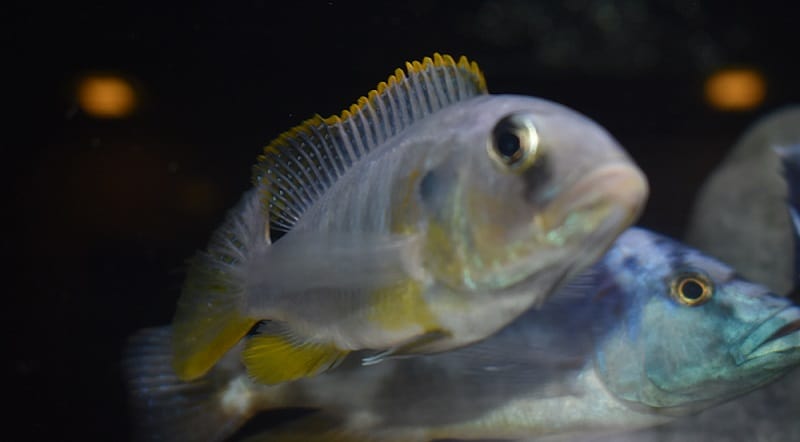
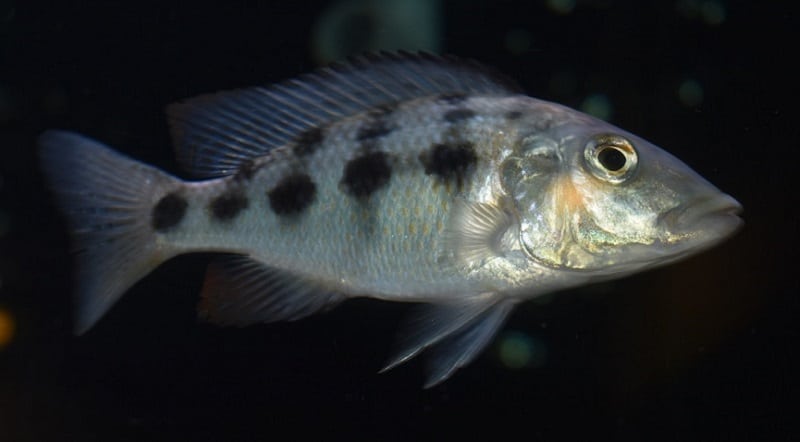
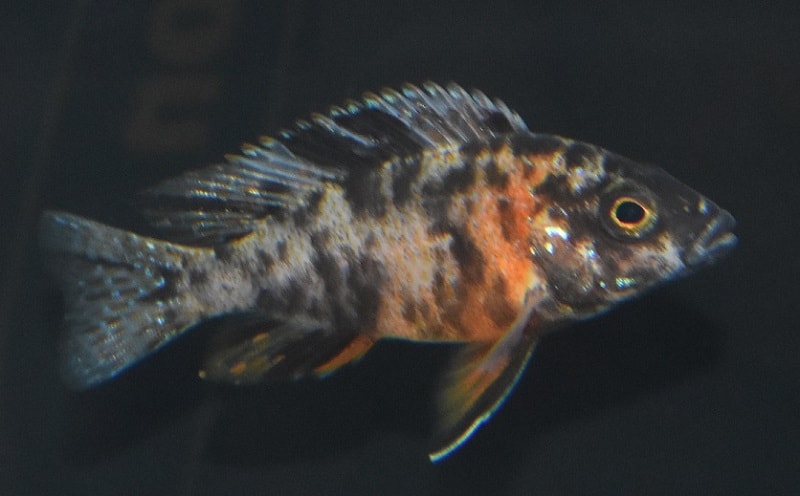
For breeding groups, unless I’m in a hurry to get the breeding project going, I prefer to buy a group of unsexed juvenile fish. As the fish develop you will be able to differentiate the males from the females and pick your most stunning guy to be the breeder male. It should be easy enough to sell the additional males when the time comes.
Young African cichlids fed hormone food:
You have probably already witnessed this if you’ve been to a fish shop that had a tank full of 1 to 2 inch juvenile African peacock or hap cichlids all colored up to the max.
If it looks too good to be true it probably is too good to be true. By right, in a juvenile tank, there may be one or two dominant males showing color at that size. The majority of the fish should be a brown color with possibly some other males showing signs of coloring up.
When fed these color enhancing hormone food both male and female fish show unnaturally strong colors. It also causes females to develop long pointed fins and they will look identical to males.
This hormone food is very different from color enhancing foods, which only bring out the natural color of the fish and do not cause any change in the appearance of the females.
There are a few reasons for using hormones to color up the fish.
- For the suppliers to be able to properly identify batches of young fish.
- To temporarily color up a female fish for identification purpose.
- To increase profits as both young male and female fish are colored up and easier to sell.
While the fish may look stunning initially the color will fade after about 2 to 4 weeks, after that you will be left with a dull brown fish. If the fish is male it may develop normal colors as it matures. Females will remain their natural brown color and never regain the color shown when you bought it.
In addition to the disappointment of the change in the fish’s appearance, there are various health issues associated with these hormone foods. These include stunted growth, sterility, and males may never color up.
All that being said, I have purchased ‘juiced’ fish that have turned out to be beauties after a few months. If your options for buying African cichlids are limited it is worth a shot, just be aware of the situation and expect the fish to lose all that color initially.
Adding new African cichlids to your tank:
Ideally, you will be quarantining your fish before adding them to your main tank. However, if you are stocking a new tank you can use the main tank as your quarantine since all the fish are new. Once your aquarium is established you should follow the quarantine tank practice before adding more fish.
- It is best to add new fish to your tank in groups of at least 3 at a time. This will avoid a single fish being targeted and attacked by all the other fish.
- Juvenile African cichlids adapt quicker to a new environment than adult fish, adults tend to get stressed and may not eat for a few days. Just make sure that the new fish isn’t small enough to be eaten by any of the bigger fish.
- Feed your fish just as you are about to release the new fish into the tank. This will give the new occupant a few minutes to settle in before being noticed by the other fish.
- Another thing that helps is to get your fish to darken up before releasing it into the tank. When a fish is kept in a white styrofoam box or bag its color will lighten up to match its surroundings. A bright fish like that will attract the attention of other fish and be an easy target for other fish. Place the fish in a dark let the fish darken up before releasing it into the tank.
- For hap and peacock tanks I don’t bother rearranging the hardscape, they are not as territorial as mbuna. Moving around the rocks is only a temporary distraction and the fish will soon go back welcoming the newcomers. Additionally, when I have put some effort into setting up a nice hardscape I don’t want to change it around.
On a final note, once you have a balanced tank where aggression is at a manageable level stop adding more fish.
Thanks for reading. If you found this article helpful, don’t forget to share 🙂

